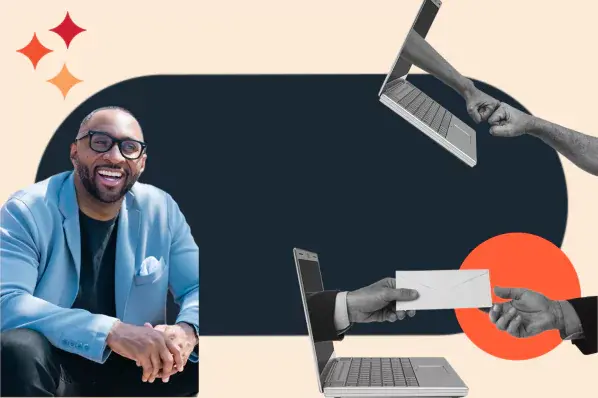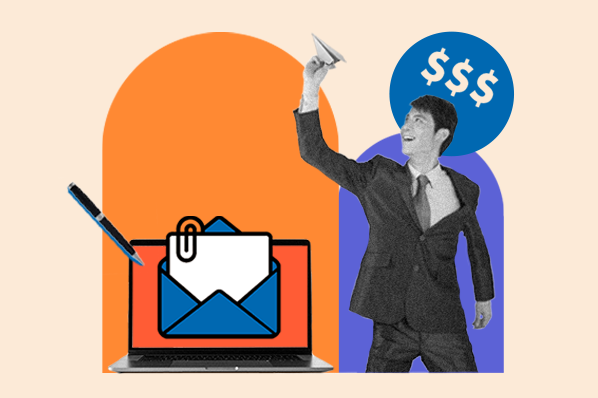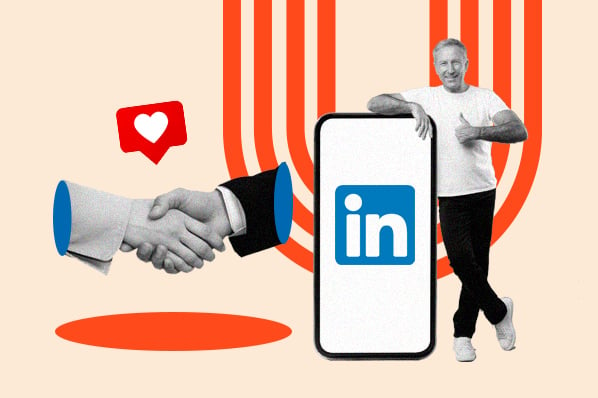1) Not having a picture.
It's disconcerting to people when they can't put a face to a LinkedIn profile. So much so, in fact, that profiles with pictures are 11x more likely to be viewed. If you don't have a picture, you're missing out on a considerable amount of profile traffic from recruiters, prospects, influencers, colleagues, and a bunch of others who aren't even on your radar. If you think about views as votes, you're losing the election to become someone's salesperson, next hire, or new connection by a landslide.
Granted, it's better to have a bad picture than none at all. Still, there are some types of pictures that are bound to scare away the people you're looking to connect with. If your picture contains duck lips, a bathroom mirror, a dog/cat, a beer, a pained expression, or a cheesy power pose, get a new one. ASAP.
2) Not having a summary.
As a writer, I completely understand the fear a totally blank page can strike into your heart. Instead of writing any summary -- perfect or less so -- some LinkedIn members succumb to intimidation, and just forgo it entirely. This is unfortunate. The summary section is the place where you can let your personality and passion shine through. Without it, your profile might as well just be a resume, which isn't terribly interesting to most people (recruiters excepted). If your profile is lacking a summary, commit to sit down and write one.
3) Writing your profile like a resume.
I don't think LinkedIn would've taken off like it did if it was merely a database of resumes. Resumes are stiff, formal, and self-promoting. LinkedIn profiles, on the other hand, should be conversational, personal, and other-promoting. Not sure what I mean? Take a salesperson for example. Instead of bragging about how many months they surpassed quota by X%, a sales rep's LinkedIn profile should instead describe the success they've helped customers achieve and brag about their accomplishments. By promoting clients instead of themselves, the salesperson will attract prospects rather than recruiters.
4) Headlines packed with buzzwords.
"Guru." "Ninja." "Rockstar." Unless you're a spiritual master, a secretive assassin, or a member of Van Halen (respectively), these words should not be in your headline. Not only are they over the top and cringe-inducing, they're also self-promoting, which we've already established is a no-no. Instead, Craig Rosenberg recommends answering the question "Who do I help and how do I help them?"
5) Writing in third person.
If you don't address yourself in the third person in everyday conversation (and I really hope you don't), why would you write your profile like that? Even Barack Obama describes his current position on Linked In as "I am serving as the 44th president of the United States of America," so I think you can stand to drop the third person language.
6) Not including an email address or Twitter link.
Salespeople should make it as easy as possible for prospects to find them and reach out to them. For this reason, make sure to include additional contact information and link to other social media accounts on your profile. Buyers want to work with people who are readily accessible, and there's nothing more frustrating than having to hunt down an email address when it should just be there.
7) Throwing keywords to the wind.
And speaking of getting found, why is it that we're ultra-conscientious about inserting SEO keywords into our personal websites but not at all when writing our LinkedIn profiles? Sprinkling in a few keywords throughout your LinkedIn profile that your target audience is likely searching for has been proven to boost views. The job of a sales rep becomes a whole lot easier when your ideal buyers come to you, so don't neglect this crucial step.
8) Asking for something way too soon.
I accept most anyone into my network so long as they write a brief message in their request (more on that later). This works out well 99% of the time. But occasionally, I'll get a spammy message seconds after I accept someone, asking if I can take a half hour meeting to talk about synergy, or provide three referrals in X area. Whoa there. You wouldn't demand something of someone you just met in person, so why would you do this on LinkedIn? If you have an ask, warm up your new connection first by commenting on one of their posts, or sharing an interesting article with them.
9) Not personalizing connection requests.
You might think sending a few "I'd like to add you to my professional network on LinkedIn" requests aren't so bad. Unfortunately, you're wrong. According to HubSpot's "Is Social Selling Creepy?" survey report, 64% of buyers and consumers said they'd regard a generic LinkedIn request from a salesperson as "creepy." Don't scare your prospects away. Customize your requests using this template as a model.
10) Sending pointless messages.
These are preferable to messages that ask for something way too soon, but still. People are busy, and reading a message like "Have a great week" or "Good to meet you" takes up time without adding value to the relationship. Unless you have something worthwhile to share, skip the message, and go "like" a few of your prospect's posts instead.
11) Sending spammy InMails.
LinkedIn should not be treated as another channel to spam people on. If you're mass sending InMails to everyone in your network, you're doing it wrong. Any interest you might receive in your message will likely by counteracted by a significant number of disconnects. If your message isn't specific enough to be intended for one person and one person alone, don't send it at all.
12) Being overly selective about your network.
I know not everyone will agree with me here, but from my perspective, there's no real downside for salespeople to accept the majority of requests they receive. The more people you have in your network, the bigger reach you have. The bigger reach you have, the more potential referrals at your disposal to call on and get introduced to a prospect. Of course, however you'd like to craft your network is up to you. But if a person has a valid reason for wanting to connect with you and said as much in their personalized connection request, why not accept them?
13) Not taking advantage of profile views.
Profile views aren't just ego boosters -- they're also conversation starters. If someone looks at your profile, consider sending them a message asking what sent them by. Once you get the context around the view, you're free to pursue a relationship. Check out how sales trainer Rick Roberge uses this tactic to his benefit in this post.
14) Leaving your "Recommendations" section empty.
Social proof is incredibly powerful in business today, and what is a LinkedIn recommendation if not a mini-endorsement? A sparse or bare Recommendations section is wasted real estate that could be valuable for getting a new job or attracting buyers. With this in mind, salespeople would be wise to request recommendations from their customers, vouching for a positive buying experience and ongoing relationship. If you're not sure how to approach such a request, put this recommendation-seeking email template to work, and watch the social proof roll in.
15) Posting a single piece of content to more than one group.
It's understandable to want your post to be viewed by as many people as possible. But when you publish the same article in two or three groups in a row, it shows up in your connections' feeds as three identical back to back items. And nothing makes you look like a spammer more than having the same post show up multiple times. If you'd like to post one article in multiple groups, be sure to space out your publishing times so you don't annoy your network.
16) Leaving pointless comments.
If you read a post and you're not compelled to make a substantive comment, that's fine. A "like" will suffice, and it's much better for all involved than a pointless comment such as "Great!" or "Good!" If you're not prepared to advance the conversation, don't enter it at all.
17) Only using groups to promote yourself.
Would you stay friends with someone who randomly showed up to get-togethers and then refused to talk about anything but themselves? Not a chance. So why do the same thing on LinkedIn? Users who use groups solely to post links to their blog, company website, newsletter, or product pages will quickly develop a bad reputation.
Occasionally promoting yourself is fine, but make sure it's both relevant and not the only type of content you contribute.
18) Being stingy with your "likes."
Social selling isn't just about messaging and connecting with potential prospects. It's also about interacting with a buyer on social so when you do reach out with a call or email, it's not so out of the blue. One of the best ways to do this is by "liking" a prospect's posts. Even if the buyer doesn't really know who you are, they'll gain a sense of familiarity with your name and associate you with positive feelings. So don't be stingy with your likes -- spread 'em around like virtual pats on the back.
19) Not turning your activity feed off when updating your profile.
"Emma has a new profile picture." "Emma updated her volunteer experience." "Emma has a new skill." Thrilling news for your connections to receive in their feeds (/sarcasm). When you're doing a major overhaul on your profile, make sure to set the "notify your network" option to "no." That way, your connections won't be tired of your updates when you post something of substance you'd actually like people to read.
20) Not being a member of a single group.
This is a sin for so many reasons. First off, did you know you can message group members without being connected with them? Not to mention that people often look at the Group section of your profile to get a sense of your interests. Finally, people will connect with you based on a shared group. But if you don't have any groups to speak of, you won't reap any of these benefits. Join and participate.
21) Not taking advantage of LinkedIn publishing.
Blogging can be intimidating for someone who's never done it before. But consider the fact that every time you hit "publish post" in LinkedIn, your entire network receives a notification. That's a lot of totally free promotion for your inbound marketing efforts. If you're in sales, show buyers they can trust you with their business by writing up your thoughts on an industry shift.
22) Viewing profiles anonymously.
As I said above, profile views can start conversations. Unfortunately, people can't strike up a relationship with "LinkedIn member." You're on LinkedIn to expand your network, so don't hide behind an anonymous grey box.
23) Updating your LinkedIn once -- and never again.
We get it: Your primary focus is selling, which means refreshing your LinkedIn profile probably isn't high on your daily to-do list. However, your page will quickly get stale without periodic attention.
Every two to five months, review it for out-of-date information and any missing details. For example, maybe your customers' average ROI used to be around 20%. But now that the product is more robust, it's shot up to 30%. Adjusting that statistic is an easy win.
Or maybe you've gotten a glowing testimonial from a client since the last time you updated your profile. You'd definitely want to include that compelling piece of social proof.
24) Not following any influencers.
One of the best ways to get into your prospect's mind is following the influencers they subscribe to on LinkedIn. You'll get exposure to the same ideas, news, and viewpoints as them -- which will not only help you understand where they're coming from but will give you valuable fodder for conversation as well.
To find the best influencers to follow, visit the profiles of 10 or so of your best customers and copy the accounts in their "Interests" section.
25) Being passive about your "Skills" section.
People will typically endorse you for skills whether you ask them to or not. Yet letting others decide what appears in this section is a missed opportunity. You want to be recognized for the abilities that will most attract new prospects, like "inbound marketing" if you offer an inbound marketing platform or "digital advertising" if you work in media sales.
First, identify the top three skills you'd like to be known more. (LinkedIn's new profile update highlights the three skills you've been endorsed for most frequently.)
Then, send an email to your coworkers, professional connections, and partners asking if they'd be willing to endorse you for those skills. Most will be happy to do so -- make sure you offer to return the favor by endorsing them for their own top skills.
26) Reaching the commercial use limit.
LinkedIn's commercial use limit comes into effect when you're running an above-normal number of searches. It's a little tricky, because LinkedIn won't give you an exact number to stay under. However, you will get a notification when you're coming close to the limit. But there's nothing worse than hitting that max by accident on the 15th and being out of the prospecting game for the rest of the month. To avoid this fate, pay attention to your warning alert. Getting those a lot? You may want to consider upgrading to Sales Navigator -- which has no limit on searches.
LinkedIn isn't the easiest platform to master. Case in point: We found 26 sins to include on this list. However, armed with your new knowledge of what to avoid, you can use LinkedIn to its full advantage.
Social Selling on LinkedIn



![Here’s how to write a professional LinkedIn headline to 10x your presence [+ examples]](https://53.fs1.hubspotusercontent-na1.net/hubfs/53/linkedin%20headline%20featured.webp)
![15 Best LinkedIn Summary & Bio Examples [+ How to Write Your Own]](https://53.fs1.hubspotusercontent-na1.net/hubfs/53/linkedin-summary-examples-4.jpg)



.jpg)

![How to Write InMail Messages to Recruiters on LinkedIn [Samples + Templates]](https://53.fs1.hubspotusercontent-na1.net/hubfs/53/how-to-craft-an-inmail-that-gets-results-1.jpg)

